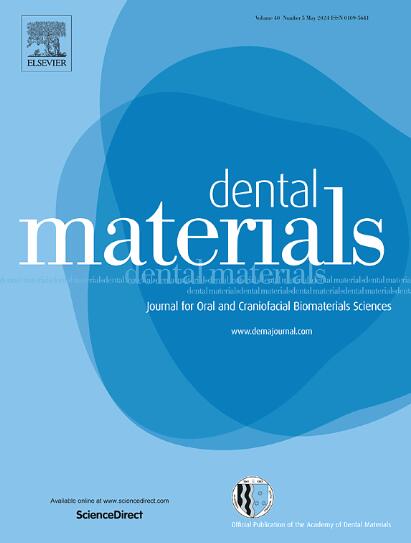通用粘合剂系统与珐琅质的粘合性能--酸性成分的影响。
IF 4.6
1区 医学
Q1 DENTISTRY, ORAL SURGERY & MEDICINE
引用次数: 0
摘要
目的:通过分析不同酸性成分的通用胶粘剂体系的润湿性、形貌变化和与牙釉质的微剪切粘接强度(µSBS),评价其自蚀刻粘接潜力。方法:对8种通用胶粘剂:All-Bond universal (Bisco)、Ambar universal (FGM)、Gluma Bond universal (Kulzer)、OptiBond universal (Kerr)、Peak universal Bond (Ultradent)、Prime&Bond universal (Dentsply)、Singlebond universal(3 M ESPE)和Tetric N-Bond universal (Ivoclar)进行了测试。根据制造商的说明,用每种粘合剂制备和处理牛门牙。通过接触角测试胶粘剂的润湿能力;用光学轮廓术评价黏合剂应用后的地形变化;能量色散x射线光谱学(EDX)用于定量牙釉质中无机元素的去除;和µSBS来验证粘合剂与牙釉质的粘合潜力。统计分析采用方差分析、Kruskal-Wallis分析、威布尔分析、Pearson相关分析和卡方检验(α=0.05)。结果:涂胶后即刻接触角与30 s后接触角有显著差异,Gluma Bond Universal和Tetric N-Bond Universal分别表现出最低(最佳润湿能力)和最高(最低润湿能力)。EDX显示不同程度的Ca和P还原,Gluma Bond Universal导致釉质中Ca和P的最大还原(分别为~ 65 %和~ 62 %)。地形分析表明粗糙度发生了显著变化,主要是针对Gluma Bond Universal。µSBS平均值从14.7 MPa (Ambar Universal)到26.8 MPa (Tetric N-Bond Universal)不等。OptiBond Universal和Tetric N-Bond Universal表现出最高的树脂-珐琅键合。为了更好地了解测试粘合剂的粘接可靠性,进行了Weibull分析,OptiBond Universal显示出增加的模量和特征强度,是牙釉质粘接中最有趣的成分之一。羧酸类胶粘剂比磷酸基单体胶粘剂的酸性更强(p = 0.033),羧酸类胶粘剂对牙釉质中Ca、p元素的去除效果更强(p = 0.029)。黏合剂处理后牙釉质的Sz值与黏合剂的基线接触角(润湿性)有很强的相关性(R²= -0.771; = 0.025页)。意义:该研究强调了通用胶粘剂在与牙釉质相互作用方面的显著差异。基于GPDM (OptiBond Universal)和10-MDP (Tetric N-Bond Universal)的粘接剂表现出最好的粘接性能,这表明它们可能更适合临床环境,因为牢固可靠的牙釉质粘接是至关重要的。10-MDP的存在与牙合的改善无显著相关。本研究结果为牙医师选择黏合剂以优化牙釉质基板的临床效果提供了有价值的信息。本文章由计算机程序翻译,如有差异,请以英文原文为准。
Bonding performance of universal adhesive systems to enamel – Effects of the acidic composition
Objectives
To evaluate the self-etch bonding potential of universal adhesive systems with varying acidic compositions by analyzing the wettability properties, topographical change, and microshear bond strength (µSBS) to enamel.
Methods
Eight universal adhesives were tested: All-Bond Universal (Bisco), Ambar Universal (FGM), Gluma Bond Universal (Kulzer), OptiBond Universal (Kerr), Peak Universal Bond (Ultradent), Prime&Bond Universal (Dentsply), Singlebond Universal (3 M ESPE), and Tetric N-Bond Universal (Ivoclar). Bovine incisors were prepared and treated with each adhesive according to the manufacturer's instructions. The following tests were carried out: contact angle to measure the adhesives’ wetting ability; optical profilometry to evaluate the topographical changes obtained with adhesives’ application; energy dispersive X-ray spectroscopy (EDX) to quantify the removal of inorganic elements from enamel; and µSBS to verify the bonding potential of adhesives to enamel. Statistical analyzes included ANOVA, Kruskal-Wallis, Weibull analysis, Pearson correlation, and chi square test (α=0.05).
Results
Significant differences were found in contact angles immediately after adhesive application and after 30 s, with Gluma Bond Universal and Tetric N-Bond Universal showing the lowest (the best wetting ability) and the highest values (the lowest wetting ability), respectively. EDX revealed varying degrees of Ca and P reduction, with Gluma Bond Universal resulting in the greatest Ca and P reduction from enamel (∼65 % and ∼62 % reduction, respectively. Topographical analysis indicated significant changes in roughness, mainly for Gluma Bond Universal. The µSBS mean values ranged from 14.7 MPa (Ambar Universal) to 26.8 MPa (Tetric N-Bond Universal). OptiBond Universal and Tetric N-Bond Universal exhibited the highest resin-enamel bonds. Weibull analysis was performed to better understand the bonding reliability of the tested adhesives, with OptiBond Universal demonstrating increased modulus and characteristic strength, performing as one of the most interesting compositions for enamel bonding. Adhesives based on carboxylic acids were more acidic than adhesives containing phosphate-based monomers (p = 0.033), and the removal of Ca and P elements from enamel was more intense with the use of adhesives based on carboxylic acids (p = 0.029). There was a strong relationship between the Sz values of adhesively treated enamel and the baseline contact angle (wettability) of adhesives (R² = −0.771; p = 0.025).
Significance
The study highlights significant variability among universal adhesives in terms of their interaction with enamel. Adhesives based on GPDM (OptiBond Universal) and 10-MDP (Tetric N-Bond Universal) demonstrated the best bonding performance, suggesting they may be preferable in clinical settings where strong and reliable enamel bonds are critical. The presence of 10-MDP was not significantly associated with improved dental bonds. The present findings provide valuable information for dentists in selecting adhesives that optimize clinical outcomes in enamel substrate using the self-etching adhesive approach.
求助全文
通过发布文献求助,成功后即可免费获取论文全文。
去求助
来源期刊

Dental Materials
工程技术-材料科学:生物材料
CiteScore
9.80
自引率
10.00%
发文量
290
审稿时长
67 days
期刊介绍:
Dental Materials publishes original research, review articles, and short communications.
Academy of Dental Materials members click here to register for free access to Dental Materials online.
The principal aim of Dental Materials is to promote rapid communication of scientific information between academia, industry, and the dental practitioner. Original Manuscripts on clinical and laboratory research of basic and applied character which focus on the properties or performance of dental materials or the reaction of host tissues to materials are given priority publication. Other acceptable topics include application technology in clinical dentistry and dental laboratory technology.
Comprehensive reviews and editorial commentaries on pertinent subjects will be considered.
 求助内容:
求助内容: 应助结果提醒方式:
应助结果提醒方式:


